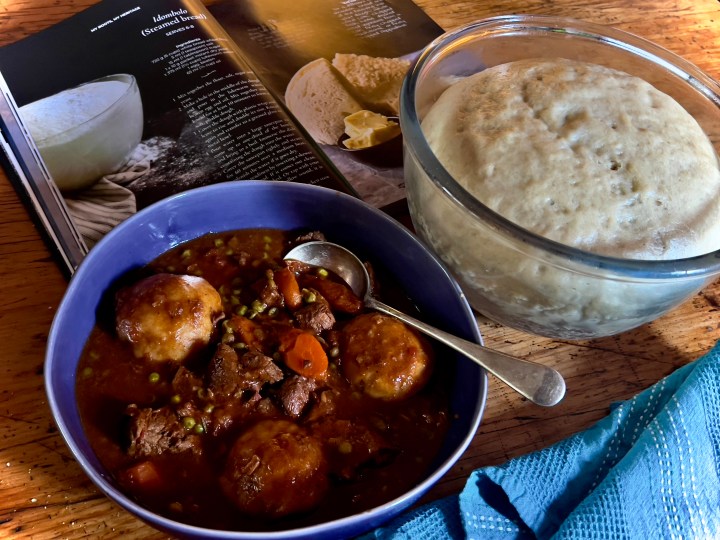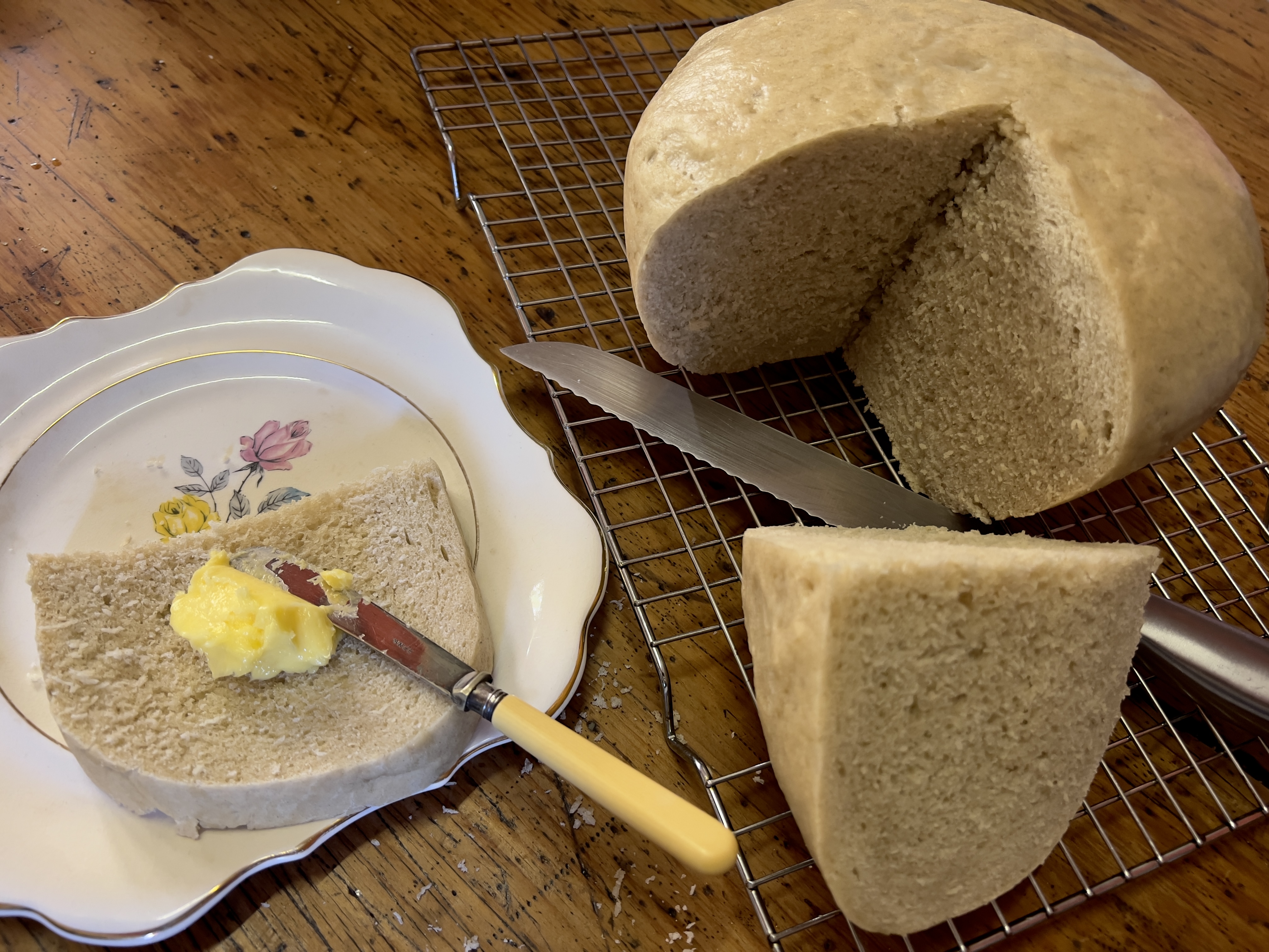BREAD OF LIFE
Throwback Thursday: Dombolo

Dombolo, or iDombolo, is South Africa’s traditional steamed bread, but the dough can also be turned into dumplings or used to make vetkoek, another great local tradition. It is deeply satisfying to make, moist and delicious just as it is, spread with butter.
Dombolo, if taken literally, means dumpling, as my esteemed colleague Hilary Biller explained in a feature for Sowetan Live. The enforced lockdown, when we all bunkered down in our kitchens and made lots of bread and many other things, didn’t only turn sourdough loaves into a global trend. In South Africa, dombolo took off too, with many who had scarcely even heard of it trying their hands at turning out this wonderful steamed bread.
And it really is very special. The steaming gives it a moistness but also a soft yet strangely firm texture. It is one of the wonders of breadmaking and it’s fascinating to hear the pot, with its lid on tightly, burbling away while a great big lump of dough slowly turns into a bread shaped like the bowl you have made it in.
You can also make bread rolls with it by using a large muffin pan, which would be cooked in a bain marie setup by placing it in a bigger oven pan filled with water (to a point) and covered tightly with foil.
Or drop lumps of the dough into bubbling fat to make vetkoek to be served with curried mince. I am also eyeing my new air fryer with interest and pondering the idea of trying some or other variation of dombolo dough in it; perhaps dombolo bread rolls brushed with oil.

Dombolo bread as it is once it’s been turned out onto a wire rack and sliced. (Photo: Tony Jackman)
Some foodies, Biller writes, “are adamant that dombolo and dumplings are two different things”. And this argument crops up all over the place so it is undoubtedly valid.
But my experience this week convinces me that it need not be either/or, but both. Exactly the same dough recipe can be used for either a loaf or dumplings. This week I made the dough twice, once for a loaf, the other for dumplings, and turned out a hearty beef stew to go with the latter.
I consulted, online, those who know better than I as to how to make it, from Dorah Sitole to dombolo recipes by the Lazy Makoti (Mogau Seshoene) and Zola Nene, who seems to prefer the dough in dumpling form served in a stew.
The late and wonderful Sitole’s superb swansong, 40 Years of Iconic Food (NB Publishers), features in the main photo for this story out of respect for her. I spoke to her shortly before she died while writing about her fabulous book and it was terribly sad that she left us so soon after producing this excellent epitaph. Read Dorah Sitole 1953-2021: a brilliant career culminated in an iconic work. My recipe is not a clone of hers (she used much more flour) but I want to nod in her direction regardless. She is greatly missed.
I started by planning to use four cups of flour but found it too sticky so gradually added more until it became four and a half cups and the dough had formed nicely. I used 2 Tbsp sugar in it (sugar is a key part of the recipe) and on tasting the final result I was pleased that it was, I thought, the right amount of sweetness without being overly sweet. Some recipes call for as much as half a cup of sugar, others for only one tablespoon of it.
The only yeast you need is a small 10 g packet of dried yeast, but make sure it’s of a recent date as it does lose its power over time. And don’t forget that pinch of salt, especially given the sugar content. In fact, I used about four grindings of salt.
If you like dombolo as much as I do, I suspect you might add this to your kitchen repertoire. Next I’m going to try the dough as a potbread out at the braai. I’ll get back to you about that.
Ingredients
4 ½ cups white bread wheat flour
Pinch of salt
2 Tbsp sugar
10 g dry yeast
500 ml lukewarm water
¼ cup canola or sunflower oil
2 large eggs, beaten
Method
Sift the flour into a large bowl. Stir in the salt and sugar, then the yeast.
Make a well in the middle and pour in the lukewarm water, oil and beaten eggs. Stir it all together with a wooden spoon until combined, then work it with clean, floured hands into a soft but firm dough.
Knead it for about five minutes: turning, folding, kneading, and repeating.
Let it rise for an hour in the bowl in a warm place, covered with a damp cloth.
Punch it down and knead for another 5 minutes.
Remove to a greased heavy glass bowl (ovenproof).
Place the bowl in a pot of water (I used a Dutch oven) to come two-thirds of the way up the side and bring the water to a simmer. Put the lid on tightly and let it steam for about an hour.
To test whether the bread is cooked through, insert a skewer well into it. It should come out clean. Mine, after an hour, was not quite ready so I gave it another 10 minutes.
Let the dombolo cool in the bowl on a wire rack (for cool air to circulate underneath the bowl), then turn the loaf out onto a wire rack once it’s cooled to room temperature.
Alternatively, once the dough has risen, break off lumps of it and roll them into balls with your palms. Drop them into your favourite stew, whether beef, chicken or lamb, and leave them to soak up the sauce and cook through, which should take about 45 minutes on a gentle heat. DM/TGIFood
Tony Jackman is the winner of a regional Vodacom Journalist of the Year (Lifestyle) award for 2022 for his features Battissian Reverie: A Fookian feast in Somerset East, and Eye in the Sky: Paint your celestial palette in Vincent’s hues, as well as Galliova Food Champion 2021.
Follow Tony on Instagram @tony_jackman_cooks.
Mervyn Gers Ceramics supplies dinnerware for the styling of some TGIFood shoots.
SUBSCRIBE to TGIFood here. Also visit the TGIFood platform, a repository of all of our food writing.






 Become an Insider
Become an Insider
Comments - Please login in order to comment.